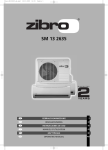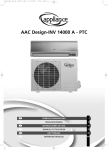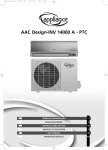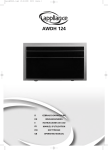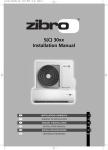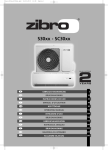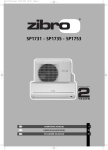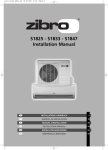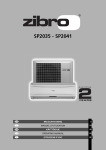Download Zibro S1833 Technical data
Transcript
man_S18xx_de.qxd 11-01-2008 11:22 Pagina 1 S1825 - S1833 - S1847 2 GEBRAUCHSANWEISUNG 2 6 BRUGSANVISNING 22 5 INSTRUCCIONES DE USO 42 3 MANUEL D'UTILISATION 62 FIN KÄYTTÖOHJE 82 4 OPERATING MANUAL 102 man_S18xx_uk.qxd 11-01-2008 11:46 Pagina 102 Dear Sir, Madam, Congratulations on the purchase of your Zibro airconditioner. You have acquired a high quality product that, if used responsibly, will give you many years of pleasure. Please read these instructions for use first in order to ensure the maximum life span of your airconditioner. On behalf of the manufacturer, we provide a 24-month guarantee on all material and production defects. Please enjoy your airconditioner. Yours sincerely, PVG International b.v. Customer service department 1. READ THE DIRECTIONS FOR USE FIRST. 2. IN CASE OF ANY DOUBT, CONTACT YOUR DEALER. 4 102 man_S18xx_uk.qxd 11-01-2008 11:46 Pagina 103 CONTENTS A SAFETY INSTRUCTIONS 104 B. PARTS NAMES 105 C. OPERATING TEMPERATURE 106 D. MANUAL OPERATION 107 E. OPERATION WITH REMOTE CONTROL 108 F. OPTIMAL OPERATION 112 G. ADJUSTING AIR FLOW DIRECTION 113 H. HOW THE AIR CONDITIONER WORKS 114 I. MAINTENANCE 115 J. OPERATION TIPS 117 K. TROUBLESHOOTING TIPS 118 L. GUARANTEE CONDITIONS 120 M. TECHNICAL DATA 121 READ THIS MANUAL Inside you will find many helpful hints on how to use and maintain your air conditioner properly. You will find many answers to common problems in the chapter Troubleshooting Tips. If you review chapter K “Troubleshooting Tips” first, you may not need to call for service. 4 103 man_S18xx_uk.qxd A 11-01-2008 11:46 Pagina 104 SAFETY INSTRUCTIONS Install the device only when it complies with local regulations, by-laws and standards. The unit is only sui- G table for use in dry locations, indoors. Check the mains voltage and frequency. This unit is only suitable for earthed sockets, connection voltage 220 - 240 V. / 50 Hz. IMPORTANT • The device MUST always have an earthed connection. If the power supply is not earthed, you may not connect the unit. The plug must always be easily accessible when the unit is connected. Read these instructions carefully and follow the instructions. • The airconditioner contains a refrigerant and can be classified as pressurized equipment. Therefore always contact an authorized installation specialist for installation and maintenance of the airconditioner. It is to be advised that the airconditioner is inspected and serviced on an annual base by an authorized airconditioning engineer. Before connecting the unit, check the following: • The voltage supply must correspond with the mains voltage stated on the rating label. • The socket and power supply must be suitable for the current stated on the rating label. • The plug on the cable of the device must fit into the wall socket. • The device must be placed and mounted on a stable surface. The electricity supply to the device must be checked by a recognised professional if you have any doubts regarding the compatibility. • This device is manufactured according to CE safety standards. Nevertheless, you must take care, as with any other electrical device. • Do not cover the air inlet and outlet grill. • Never allow the device to come into contact with chemicals. • Never spray the unit with or submerge in water • Do not insert hands, fingers or objects into the openings of the unit. • Never use an extension cable to connect the device to the electric power supply. If there is no suitable, earthed wall socket available, have one installed by a recognised electrician. • For safety reasons take care when children are in the surrounding of the device, as with any other electrical device. • Have any repairs and/or maintenance only carried out by a recognised service engineer or your recognised Zibro supplier. Follow the instructions for use and maintenance as indicated in the user manual of this device. • Always remove the plug of the unit from the wall socket when it is not in use. • A damaged power cord or plug must always be replaced by a recognised electrician or your supplier. • Do not operate or stop the airconditioner by inserting or pulling out the power plug. Only use the dedicated buttons on the airconditioner or on the remote control. • Do not open the airconditioner when it is in operation. Always pull out the electrical plug when opening the device. • Always pull out the electrical plug when cleaning or servicing the airconditioner. • Do not place gas burners, ovens and/or stoves in the airstream. • Do not operate the buttons or touch the airconditioner with wet hands. • Note that the outdoor unit produces sound when in use, this could interfere with local legislation, it is the responsibility of the user to check and to make sure the equipment is in full compliance with local legislation. 4 104 man_S18xx_uk.qxd B 11-01-2008 11:46 Pagina 105 G • It is advised to stay out of the direct airstream. • Never drink the drain water from the airconditioner. ATTENTION! • Never use the device with a damaged power cord, plug, cabinet or control panel. • Failing to follow the instructions may lead to nullification of the guarantee on this device. PART NAMES INDOOR UNIT Indoor unit a Front panel 3 2 1 10 b Air inlet c Air filter (behind front panel) d Air outlet e Horizontal air flow grille 8 f Vertical air flow louver g Display panel 4 5 h Remote controller signal receiver 6 7 i Remote controller (see chapter E for more details and operation) j Manual control button (auto/cool) 9 OUTDOOR UNIT Outdoor unit 12 11 k Connecting pipe, drain hose (not included) l Air inlet (side and rear) m Air outlet 13 G The operation indicator lights flash rapidly (five times per second) when safety protection features come into operation. NOTE! All the pictures in this manual and on the gift box are for explanation and indication purpose only. They may be slightly different from the air conditioner you purchased. The actual shape shall prevail. 4 105 man_S18xx_uk.qxd 11-01-2008 11:46 Pagina 106 FUNCTION INDICATORS ON INDOOR UNIT DISPLAY PANEL 1 a 2 3 4 5 6 AUTO indicator This indicator illuminates when the air conditioner is in AUTO operation. b TIMER indicator This indicator illuminates when TIMER is set ON/OFF. c PRE.-DEF. Indicator This indicator illuminates when the air conditioner starts defrosting automatically or when the warm air control feature is activated in heating operation. d TEMPERATURE indicator A) Usually it displays the temperature settings. When change the setting temperature, this indicator begins to flash, and stops 20 seconds later. B) It displays the room temperature when the air conditioner is in FAN only operation. C) When the unit stops operation, it return to original factory settings. D) Displays the malfunction code or protection code if applicable. e OPERATION indicator This indicator flashes after power is on and illuminates when the unit is in operation. f FREQUENCY indicator This indicator appears only when the compressor is in operation and indicates the current operating frequency. C OPERATING TEMPERATURE Cooling, heating and dehumidifying are most effective at the following indoor and outdoor temperatures: Mode Cooling operation Heating operation Dehumidifying operation Room temperature 17ºC - 32ºC 10ºC - 27ºC 17ºC - 32ºC Outdoor temperature 18ºC - 40ºC 10ºC - 24ºC 18ºC - 40ºC Temperature G CAUTION • If air conditioner is used outside of the above conditions, certain safety protection features may come into operation and cause the unit to function abnormally. • Room relative humidity less than 80%. If the air conditioner operates in excess of a relative humidity of 80% in the room, the surface of the air conditioner may attract condensation. Please set the vertical air flow louver to its maximum angle (vertically to the floor), and set HIGH fan mode. • For maximum effect of your air conditioner always close doors and windows when cooling or heating. 4 106 man_S18xx_uk.qxd D 11-01-2008 11:46 Pagina 107 MANUAL OPERATION The air conditioner can be operated manually on the air conditioner itself as well as with the remote control included. For operation with the remote control please refer to chapter E “Operation with Remote Control”. When operating without the remote control the air conditioner will only work in the AUTO-mode. For operation without the remote control follow these instructions: Panel Manual control button 1. AUTO / COOL Open and lift the front panel up to an angle until it remains fixed with a clicking sound. 2. One press of the manual control button j will lead to the AUTO operation. 3. Close the panel firmly to its original closed position. G CAUTION • Once you push the manual button, the operation mode is shifted in an order as: AUTO, COOL, OFF. • Push the button twice, the unit will operate in forced COOL mode. This is used for testing purposes only . • Third press will stop the operation and turn off the air conditioner operation. • To restore the remote controller operation, use the remote controller directly. 4 107 man_S18xx_uk.qxd E 11-01-2008 G 11:46 Pagina 108 OPERATION WITH REMOTE CONTROL NOTE! • Always aim the remote controller towards the receiver on the indoor unit and make sure there are no obstacles in between the remote control and the receiver on the indoor unit. Otherwise the remote control signal will not be picked up by the receiver and the air conditioner will not work properly. • The maximum distance at which the remote control will work is approximately 6 to 7 meters. Introduction of Function Buttons on the Remote Controller fig. 1 a On/off Button: Push this button to start the unit operation. Push the button again to stop the unit operation. b Mode Button: Each time you press the button, a mode is selected in a sequence that goes from AUTO COOL DRY HEAT and FAN only as the following figure indicates: AUTO COOL DRY HEAT FAN c ▲ Button: Push the button to increase the indoor temperature setting to 30ºC. d ▼ Button: Push the button to decrease the indoor temperature setting to 17ºC. e Fan Button: This button is used for selecting Fan Speed. Each time you press the button, a fan speed is selected in a sequence that goes from AUTO, LOW, MED to HIGH, then back to Auto. When you select the AUTO or DRY mode, the fan speed will be automatically controlled and you can not set the fan speed. f SLEEP Button: Press this button to go into the Energy-Saving operation mode. Press it again to cancel. This function is only can be used on COOL, HEAT and AUTO mode and maintain the most comfortable temperature for you. NOTE: While the unit is running under SLEEP operation mode, it would be cancelled if you press the other button. g Swing Button: Press the SWING button to activate the swing feature. Push the button again to stop. h Air direction Button: Press this button to change the swing angle of the louver. The swing angle of the louver is 6oC for each press. When the louver swing at a certain angle which would affect the cooling and heating effect of the air conditioner, it would automatically change the swing direction . No symbol will appear in the display area when press this button. i Timer on Button: Press this button to initiate the auto-on time sequence. Each press will increase the 4 108 man_S18xx_uk.qxd 11-01-2008 11:46 Pagina 109 auto-timed setting in 30 minutes increments. When the setting time displays 10Hr, each press will increase the auto-timed setting 60 minutes increments. To cancel the auto-timed program, continue pressing the button until nothing displays. j Timer off Button: Press this button to initiate the auto-off time sequence. Each press will increase the auto-timed setting in 30 minutes increments. When the setting time displays 10Hr, each press will increase the auto-timed setting 60 minutes increments. To cancel the auto-timed program, continue pressing the button until nothing displays. k RESET Button: When you press the recessed RESET button, all current settings are cancelled and the control will return to the initial settings. l CLEAN AIR Button: This button is used to activate the function of Plasma Dust Collector. Push it again to stop the function. m LOCK Button: When you press the recessed LOCK button, all current settings are locked in and the remote controller does not accept any operation except that of the LOCK. Press again to cancel the LOCK mode. n TURBO Button: Push this button on COOL mode, the air conditioner goes into powerful cooling operation. Push again to cancel the TURBO function. o LED DISPLAY Button: Press this button to clear the digit display in the air conditioner, press it again to activate it (Not applicable to units without this function). Names and Functions of indicators on Remote Controller fig. 2 Display Panel a DIGITAL DISPLAY area: This area will show the set temperature and, if in the TIMER mode, will show the ON and OFF settings of the TIMER. If in the FAN mode, nothing is appeared. b TRANSMISSION Indicator: This indicator lights when remote controller transmits signals to the indoor unit. c ON/OFF Indicator: This symbol appears when the unit is turned on by the remote controller, and disappear when the unit is turned off. d OPERATION MODE Indicator: When press the MODE button, it shows the current operating mode -- AUTO COOL DRY HEAT (Cooling only model without) mode. e LOCK Indicator: LOCK display is displayed by pushing the LOCK button. Push the LOCK button to clear display. f TIMER DISPLAY Indicator: This display area shows the settings of the TIMER. That is, if only the starting time of operation is set, it will display the TIMER ON. If only the turning off time of operation is set, it will display the TIMER 4 109 man_S18xx_uk.qxd 11-01-2008 11:46 Pagina 110 OFF. If both operations are set, it will show TIMER ON-OFF which indicates you have chosen to set both the starting time and off time. g G FAN SPEED Indicator: Press the FAN SPEED button to select the desired fan speed setting (Auto-Low-Med-High). Your selection will be displayed in the LCD window except the Auto fan speed. NOTE! All items are shown in the Fig.2 for the purpose of clear presentation But during the actual operation only the relative functional items are shown on the display panel. Operating the Remote Controller Install / Replace Batteries Use two dry alkaline batteries (AAA/LR03). Do not use rechargeable batteries. 1. Remove the battery cover on the back of the Remote Control by pulling it according to the arrow direction shown on the cover. G 2. Insert new batteries making sure that the (+) and (-) of battery are installed correctly. 3. Reattach the cover by sliding it back into position. NOTE! • When replacing batteries, do not use old batteries or a different type battery. This may cause the remote controller to malfunction. • If you do not use the remote controller for several weeks remove the batteries. Otherwise battery leakage may damage the remote controller. • The average battery life under normal use is about 6 months. • Replace the batteries when there is no answering beep from the indoor unit or if the Transmission Indicator light fails to appear. • Never mix new and old batteries. Never use different battery types (e.g. alkaline and manganese dioxide) simultaneously. AUTOMATIC Operation When the Air Conditioner is ready for use, switch on the power and the OPERATION indicator lamp on the display panel of the indoor unit starts flashing. 1. Use the Mode select button to select AUTO. 2. Push the ▲ or ▼ button to set the desired room temperature. The most comfortable temperature settings are between 21ºC to 28ºC. 3. Push the On/off button to start the air conditioner. The OPERATION lamp on the display panel of the G indoor unit lights. The operating mode is AUTO. The FAN SPEED is automatically controlled. 4. Push the On/off button again to stop the unit operation. 4 110 NOTE! • In the AUTO mode, the air conditioner can logically choose the mode COOL, FAN, HEAT and DRY by sensing the difference between the actual ambient room temperature and the set temperature on the remote controller. • If the AUTO mode is not comfortable for you , the desired mode can be selected manually. man_S18xx_uk.qxd 11-01-2008 11:46 Pagina 111 COOL, HEAT, and FAN ONLY Operation 1. If the AUTO mode is not comfortable, you may manually override the settings by using COOL, DRY, HEAT (HEAT PUMP units only), or FAN ONLY modes by pressing button b. 2. Push the ▲ or ▼ button (c and d) to set the desired room temperature. When in COOLING mode, the most comfortable settings are 21ºC or above. When in HEATING mode, the most comfortable settings are 28ºC or below. 3. Push the Fan button e to select the FAN mode of AUTO, HIGH, MED or LOW. Push the On/off button a. The operation lamp lights and the air conditioner starts to operate per your G 4. settings. Push the On/off button a again to stop this unit operation. NOTE! The FAN ONLY mode cannot be used to control the temperature. In this mode, only steps 1, 3 and 4 are applicable. DRY Operation 1. Push the Mode button b to select DRY. 2. Push the ▲ or ▼ button (c and d) to set the desired temperature from 21 C to 28 C. 3. Push the On/off button a. The operation lamp lights and the air conditioner starts to operate in the DRY G mode. Push the On/off button a again to stop this unit operation. NOTE! Due to the difference of the set temperature of the unit and the actual indoor temperature, the Air Conditioner when in DRY mode will automatically operate many times without running the COOL and FAN mode. TIMER Operation Push Timer on/off button (i and j) to set the on and off times of the unit. The effective operation time set by the remote controller for the timer function is limited to a period of between 0.5 and less than 24 hours. 1. To set the STARTING time. 1.1 Push the Timer on button i, then the remote controller display shows ON TIMER, the last set time for the starting operation and the signal "Hr" will be shown on the Timer display area. You are now ready to reset the time to START the operation. 1.2 Push the Timer on button i again to set desired unit start time. 1.3 After setting the Timer on ,there will be half a second delay before the remote controller transmits the signal to the air conditioner. 2. To set the STOPPING time. 2.1 Push the Timer off button j and the remote controller display will show OFF TIMER and the last set time for the timer off operation in hours will be shown on the Timer display area. You are now ready to reset the time of the STOP operation. 2.2 Push the Timer off button j again to set the time you want to stop the operation. 2.3 After setting the Timer off, there will be half a second delay before the remote controller transmits the signal to the air conditioner. 4 111 man_S18xx_uk.qxd 3. 11-01-2008 11:46 Pagina 112 Set the starting & stopping time 3.1 Push the Timer on button i, the remote controller display will show ON TIMER, the last set time for Timer on operation in hours will be shown on the Timer display area. You are now ready to readjust the Timer on to start the operation. 3.2 Push the Timer on button i again to set the time you want to start the operation. 3.3 Push the Timer off button j, the remote controller will show OFF TIMER, the last set time for STOP operation and the signal "Hr" will be shown on the Timer display area. You are now ready to set the time to STOP operation. 3.4 Push the Timer off button j again to set the time you want to stop the operation. G 3.5 After setting the TIMER, there will be half a second delay before the remote controller transmits the signal to the Air Conditioner. NOTE! • If the same time is set for both START and STOPPING settings, the stopping time will automatically increase 0.5hr(the set time displays less than 10Hr) or one hour (the set time displays 10Hr or more). • To change the Timer on/off time, just press the corresponding TIMER button and reset the time. • The setting time is relative time. That is the time set is based on the delay of the current time. G F WARNING • • • • Keep the Remote Controller away from all liquids. Protect the Remote Controller from high temperatures and exposure to radiation. Keep the indoor receiver out of direct sunlight or the Air Conditioner may malfunction. Never mix new and old batteries. Never use different battery types (e.g. alkaline and manganese dioxide) simultaneously. OPTIMAL OPERATION To achieve optimal performance, please note the following: • Adjust the air flow direction correctly so that it is not directly directed to people. • Adjust the temperature to achieve the highest comfort level. Do not adjust the unit to excessive temperature levels. • Close doors and windows otherwise the desired effect may be reduced. • Use TIMER ON button on the remote controller to select a time you want to start your air conditioner. • Do not put any object near air inlet or air outlet, as the efficiency of the air conditioner may be reduced and the air conditioner may stop running. Make sure there are no obstacles blocking the airflow. The air stream must be allowed to reach the entire room unhindered. Also the air stream must be allowed to reach the air conditioner unhindered. • Clean the air filter periodically, otherwise cooling or heating performance may be reduced. It is advised to clean the filters every two weeks. • Do not operate unit with horizontal louvre in closed position. 4 112 man_S18xx_uk.qxd G 11-01-2008 11:46 Pagina 113 ADJUSTING AIR FLOW DIRECTION • Adjust the air flow direction properly otherwise, it might cause discomfort or cause uneven room temperatures. • Adjust the horizontal louver using button h on the remote controller. • Adjust the vertical louver manually. Adjusting the horizontal Air Flow Direction (up - down) The air conditioner automatically adjusts the horizontal air flow direction in accorAu to On SET T EM Mo TI M E Sl R Sw Hr . T IM ER Ai Hr . Ti Ti me me rO f rD i re cti /O ff P Fa ON Off ee de n p ing on rO n f dance with the operating mode. To set the horizontal air flow direction Perform this function while the unit is in operation. Keep pressing the AIR DIRECTION button h on the remote controller to move the louver to the desired direction. Lever • Adjust the horizontal air flow direction to the desired direction. • In subsequent operations, the horizontal air flow is automatically set in the direction to which you adjusted the louver by pressing the AIR DIRECTION button. To set the vertical air flow direction (left - right) Adjust the vertical louver manually using the lever on the left or right side of the vertical louver arm (depending on model). When the air conditioner is in opera- G tion and the vertical louver is in a specific position, move the lever at left (or right, depending on model) end of the air outlet to the desired position. G CAUTION! Take care, do not touch the fan behind the vertical louvers! NOTE! All the pictures in this manual and on the gift box are for explanation and indication purpose only. They may be slightly different from the air conditioner you purchased. The actual shape shall prevail. To automatically swing the air flow direction (up - down) Perform this function while the air conditioner is in operation. • Press the SWING g button on the remote controller. • To stop the function, press the SWING button g again. Press AIR DIRECTION h button to lock louver in desired position. 4 113 man_S18xx_uk.qxd 11-01-2008 G H 11:46 Pagina 114 CAUTION • The AIR DIRECTION and SWING buttons will be disabled when the air conditioner is not in operation (including when the TIMER ON is set). • Do not operate the air conditioner for long periods with the air flow direction set downward in cooling or dry mode. Otherwise, condensation may occur on the surface of the horizontal louver causing moisture to drop. • Do not move the horizontal louver manually. Always use the AIR DIRECTION h or SWING button g. If you move this louver manually, it may malfunction during operation. If the louver malfunctions, stop the air conditioner once and restart it. • When the air conditioner is started immediately after it was stopped, the horizontal louver might not move for approximately 10 seconds. • Open angle of the horizontal louver should not be set too small, as COOLING or HEATING performance may be impaired due to too restricted air flow area. • Do not operate unit with horizontal louver in closed position. • When the air conditioner is connected to power (initial power), the horizontal louver may generate a sound for 10 seconds, this is a normal operation. HOW THE AIR CONDITIONER WORKS Press Sleep button • 1 Set Temperature AUTOMATIC OPERATION 1 hour ration depending on what temperature you have selected and the room 1 hour COOLING Press Sleep button Set Temperature When you set the air conditioner in AUTO mode (button 2 on the remote controller), it will automatically select COOLING, HEATING or FAN only ope- 1 temperature. • 1 The air conditioner will control room temperature automatically round the temperature point set by you. 1 • 1 hour 1 hour ally. HEATING Cooling Fan only Cooling Fan only Cooling ECONOMIC OPERATION • Room temperature If the AUTO mode is uncomfortable, you can select desired conditions manu- When you push SLEEP button f during COOLING, HEATING or AUTO operation, the air conditioner will automatically increase (cooling) or decrease Time Set temperature (heating) 1ºC per hour. The set temperature will be steady 2 hours later. The fan speed will be automatically controlled. DEHUMIDIFYING DEHUMIDIFYING OPERATION • The dehumidifying mode will automatically select the dehumidifying operation based on the difference between the set temperature and the actual room temperature. G • The temperature is regulated while dehumidifying by repeatingly turning on and off of the cooling operation or fan only. The fan speed is LOW. • In normal cooling operation the airconditioner will also dehumidify the air. NOTE When the airconditioner is dehumidifying it is likely that the room temperature will decrease. It is therefore normal that a hygrostat will measure a higher relative humidity. The absolute humidity in the room will however be lowered, depending on the amount of moisture produced in the room (cooking, people etc). 4 114 man_S18xx_uk.qxd I 11-01-2008 11:46 MAINTENANCE Household Drain Cleaner No Pagina 115 G G WARNING It is necessary to stop the air conditioner and disconnect the power supply before cleaning. Cleaning the indoor unit and remote controller Thinner CAUTION • Use a dry cloth to wipe the indoor unit and remote controller. • A cloth dampened with cold water may be used on the indoor unit if it is very dirty. • The front panel of the indoor unit can be removed and cleaned with water. Then wipe it with a dry cloth. • Do not use a chemically treated cloth or duster to clean the unit. • Do not use benzine, thinner, polishing powder, or similar solvents for cleaning. These may cause the plastic surface to crack or deform. Cleaning the air filter Filter handle A clogged air filter reduces the cooling efficiency of this unit. Clean the filter once every 2 weeks. 1. Lift the indoor unit panel up to an angle until it stops with a clicking sound. 2. Take hold of the handle of the air filter and lift it up slightly to take it out from the filter holder, then pull it downwards. 3. Remove the AIR FILTER from the indoor unit. • Clean the AIR FILTER once every two weeks. • Clean the AIR FILTER with a vacuum cleaner or water. • Ensure before replacing that the filter is completely dry and has no defects. G 4. Electrostatic Filter Remove the Electrostatic Plasma Filter only when applicable from its support frame as shown in the Figure on the left. 5. CAUTION! Do not touch this Electrostatic Plasma Filter within 10 minutes after opening the inlet grille, it may cause an electric shock. Clean the Electrostatic Plasma Filter with water, and, if necessary with a mild detergent. Ensure before replacing that the filter is completely dry and has no defects. 6. Install the air freshening filter back into position. 7. Insert the upper portion of air filter back into the unit taking care that the left and right edges line up correctly and place filter into position. 4 115 man_S18xx_uk.qxd 11-01-2008 11:46 Pagina 116 Maintenance If you plan to idle the unit for a long time, perform the following: 1. Operate the fan for about 6 hours to dry the inside of the unit. 2. Stop the air conditioner and disconnect power. Remove the batteries from the remote controller. 3. The outdoor unit requires periodic maintenance and cleaning. This should only be done by an authorized airconditioning engineer. Checks before operation • Check that the wiring is not broken or disconnected. G • Check that the air filter is installed. • Check if the air outlet or inlet is not blocked after the air conditioner has not been used for a long time. 4 116 CAUTION • Do not touch the metal parts of the unit when removing the filter. Injuries can occur when handling sharp metal edges. • Do not use water to clean inside the air conditioner. Exposure to water can destroy the insulation, leading to possible electric shock. • When cleaning the unit, first make sure that the power and circuit breaker are turned off. man_S18xx_uk.qxd J 11-01-2008 11:46 Pagina 117 OPERATION TIPS The following events may occur during normal operation. 1. Protection of the air conditioner. Compressor protection • The compressor cannot restart for 3 minutes after it stops. Anti-cold air • The unit is designed not to blow cold air on HEAT mode, when the indoor heat exchanger is in one of the following three situations and the set temperature has not been reached. A. When heating has just started. B. Defrosting. C. Low temperature heating. Defrosting • • The indoor or outdoor fan stops running when defrosting. Frost may be generated on the outdoor unit during heat cycle when outdoor temperature is low and humidity is high resulting in lower heating efficiency of the air conditioner. • During this condition air conditioner will stop heating operation periodically and start defrosting automatically. • The time to defrost may vary from 4 to 10 minutes according to the outdoor temperature and the amount of frost buildup on the outdoor unit. 2. A white mist coming out from the indoor unit. • A white mist may generate due to a large temperature difference between air inlet and air outlet on COOL mode in an indoor environment that has a high relative humidity. • A white mist may generate due to moisture generated from defrosting process when the air conditioner restarts in HEAT mode operation after defrosting. 3. Low noise of the air conditioner. • You may hear a low hissing sound when the compressor is running or has just stopped running. This sound is the sound of the refrigerant flowing or coming to a stop. • You can also hear a low "squeak" sound when the compressor is running or has just stopped running. This is caused by heat expansion and cold contraction of the plastic parts in the unit when the temperature is changing. • A sound may be heard due to louver restoring to its original position when power is first turned on. 4. Dust is blown out from the indoor unit. • This is a normal condition when the air conditioner has not been used for a long time or during first use of the unit. 5. A peculiar smell comes out from the indoor unit. • This is caused by the indoor unit giving off smells permeated from building material, from furniture, or smoke. 4 117 man_S18xx_uk.qxd 11-01-2008 11:46 Pagina 118 6. The air conditioner turns to FAN only mode from COOL or HEAT mode. • When indoor temperature reaches the temperature setting on air conditioner, the compressor will stop automatically, and the air conditioner turns to FAN only mode. The compressor will start again when the indoor temperature rises on COOL mode or falls on HEAT mode to the set point. 7. Dripping water may generate on the surface of the indoor unit when cooling in a high relatively humidity (relative humidity higher than 80%). Adjust the horizontal louver to the maximum air outlet position and select HIGH fan speed. 8. Heating mode • The air conditioner draws in heat from the outdoor unit and releases it via the indoor unit during heating operation. When the outdoor temperature falls, heat drawn in by the air conditioner decreases accordingly. At the same time, heat loading of the air conditioner increases due to larger difference between indoor and outdoor temperature. If a comfortable temperature cannot be achieved by the air conditioner, it is advised to use a supplementary heating device. 9. Auto-restart function. • Power failure during operation will stop the unit completely. The airconditioner is equipped with Auto-restart feature, when the power restores, the unit restarts automatically with all the previous settings preserved by the memory function. K TROUBLE SHOOTING TIPS G Malfunctions and Solutions TROUBLE Stop the air conditioner immediately if one of the following faults occur. Disconnect the power and contact your supplier. • The following code appears on the LED window: E0,E1,E2,E3,E4,E5,E6,E7,E8 or P0,P1,P2,P3,P4. • Fuse blows frequently or circuit breaker trips frequently. • Other objects or water penetrate the air conditioner. • The remote controller won't work or works abnormally. • Other abnormal situations. • Operation indicator flashes 5 times, even after mains electricity has been disconnected and reconnected. 4 118 man_S18xx_uk.qxd 11-01-2008 11:46 Problem Pagina 119 Cause Solution Power cut Wait for power to be restored. Unit may have become unplugged. Fuse may have blown. Unit does not start Battery in Remote controller may have been exhausted. Check that plug is securely in wall receptacle. Replace fuse / reset relay / reset circuitbraker Replace the battery. Distance remote controller to receiver on Shorten the distance. Remove possible the indoor unit is more than 6 to 7 meters, obstacles. Aim the remote controller or there are obstacles in between the towards the receiver on the indoor unit. remote controller and the receiver. The time you have set with timer is incorrect. Wait or cancel timer setting. Inappropriate temperature setting. Set temperature correctly. For detailed method please refer to "operation with remote control" chapter E. Air filter is blocked. Clean the air filter. Unit not cooling or heating room very well Doors or windows in room are open. while air flowing out from the air Air inlet or outlet of indoor or outdoor conditioner unit has been blocked. Close the doors or windows. Clear obstructions away first, then restart the unit. Compressor 3 minutes delay protection has been activated. Wait. Defrosting of outdoor unit being performed. Fan speed cannot be changed TEMP. Indicator is not shown G Airconditioner is in automode Airconditioner is in dry mode Airconditioner is in fan mode Fan speed can only be changed in HEAT, COOL and FAN mode Temperature cannot be set in FAN mode If the trouble has not been corrected, please contact your supplier. Be sure to inform them of the detailed malfunctions and unit model. NOTE! Reparation of the device should only be done by an authorized airconditioning engineer. 4 119 man_S18xx_uk.qxd L 11-01-2008 11:46 Pagina 120 GUARANTEE CONDITIONS The air conditioner is supplied with a 24-month guarantee, commencing on the date of purchase. All material and manufacturing defects will be repaired or replaced free of charge within this period. The following rules apply: 1. We expressly refuse all further damage claims, including claims for collateral damage. 2. Repairs to or replacement of components within the guarantee period will not result in an extension of the guarantee. 3. The guarantee is invalidated if any modifications have been made, non genuine parts are fitted or repairs are carried out by third parties. 4. Components subject to normal wear, such as the filter, are not covered by the guarantee. 5. The guarantee is valid only when you present the original, dated purchase invoice and if no modifications have been made. 6. The guarantee is invalid for damage caused by neglect or by actions that deviate from those in this instruction booklet. 7. Transportation costs and the risks involved during the transportation of the air conditioner or air conditioner components shall always be for the account of the purchaser. 8. Damage caused by not using suitable Zibro filters is not covered by the guarantee. 9. Refrigerant loss and/or leakage because of incompetent (dis)connecting the units is not covered by the guarantee conditions applicable to this product. To prevent unnecessary expense, we recommend that you always first carefully consult the instructions for use. Take the air conditioner to your dealer for repairs if these instructions do not provide a solution. 4 120 man_S18xx_uk.qxd M 11-01-2008 11:46 Pagina 121 TECHNICAL DATA Model S 1825 Type air-conditioner Cooling capacity (max) * W EE Class* EER* Heating capacity (max) * S 1833 S 1847 DC inverter wall mounted DC inverter wall mounted AC inverter wall mounted W Heating performance 2600 3500 5200 A A B 3.7 3.3 3.07 3000 4100 5600 A A C 4.0 3.8 3.24 L / 24h 19 29 41 Power consumption cooling kW 0.70 1.06 1.69 Power consumption heating kW 0.75 1.08 1.73 V / Hz / Ph 230 / 50 / 1 230 / 50 / 1 230 / 50 / 1 A 2.9 / 3.0 4.3 / 4.2 7.5 / 8.0 COP* Dehumidifying capacity ** Power supply Current (nom.) cooling / heating Max. Current Air flow ** For rooms up to** A 8.0 8.5 18.0 m3 /h 650 / 515 / 375 675 / 520 / 375 800 / 700 / 600 m3 Compressor type Fan speeds 65 - 90 85 - 110 130 - 150 Rotary Rotary Rotary 3 3 3 Thermostatic range ºC 17 - 30 17 - 30 17 - 30 Operating range ºC 10 - 40 10 - 40 10 - 40 Electronic remote Electronic remote Electronic remote Y Y Y Controls manual / mechanic / electronic Remote control Yes / No Screen, Plasma, Active carbon Screen, Plasma, Active carbon Screen, Plasma, Active carbon Air filter type(s) Refrigerant type / charge Refrigerant pipe diameter Liquid - Gas r / gr R410A / 1230 gr R410A / 1230 gr R410A / 1770 gr mm 6.35 / 9.53 6.35 / 12.7 6.35 / 12.7 Pressure suction / discharge bar <15 / <42 <15 / <42 <15 / <42 Dimensions indoor unit (w x h x d) mm 815 x 280 x 215 815 x 280 x 215 920 x 293 x 224 Dimensions outdoor unit (w x h x d) 845 x 695 x 335 mm 760 x 590 x 285 760 x 590 x 285 Net weight indoor unit kg 10 10 13 Net weight outdoor unit kg 42 42 63 Gross weight indoor unit kg 12 12 15 Gross weight outdoor unit kg 45 45 67 Sound pressure level indoor unit dB(A) 30 - 41 30 - 43 37 - 44 Sound pressure level outdoor unit dB(A) 52 54 58 Unit protection indoor IP IP X0 IP X0 IP X0 Unit protection outdoor IP Fuse rating * EN 14511-2004 ** To be used as indication *** Moisture removal at 32°C, 80% RH IP X4 IP X4 IP X4 T3.15A / 250V T3.15A / 250V T3.15A / 250V Waste electrical products should not be disposed with household waste. Please recycle where facilities exist. Check with your local authority or retailer for recycling advice. Environmental information: This equipment contains fluorinated greenhouse gases covered by the Kyoto Protocol. It should only be serviced or dismantled by professional trained personnel. This equipment contains R410A refrigerant in the amount as stated in the table above. Do not vent R410A into atmosphere: R410A, is a fluorinated greenhouse gas with a Global Warming Potential (GWP) = 1975 4 121 11-01-2008 11:46 Pagina 122 DISTRIBUTED IN EUROPE BY PVG INTERNATIONAL B.V. q SCHWEIZ PVG Schweiz AG Salinenstrasse 63 4133 PRATTELN tel: +41 61 337 26 51 fax: +41 61 337 26 78 email: [email protected] 2 DEUTSCHLAND PVG Deutschland GmbH Siemensstrasse 31 47533 KLEVE tel: 0800 - 9427646 fax: +31 (0)412 648 385 email: [email protected] 6 DANMARK Appliance A/S Blovstroed Teglvaerksvej 3 DK-3450 ALLEROED tel: +45 70 205 701 fax: +45 70 208 701 email: [email protected] 5 ESPAÑA PVG España S.A. Pol. Ind. San José de Valderas II Comunidad ”La Alameda” C/ Aurora Boreal, 19 28918 LEGANÉS (Madrid) tel: +34 91 611 31 13 fax: +34 91 612 73 04 email: [email protected] 3 FRANCE PVG France SARL 4, Rue Jean Sibélius B.P. 185 76410 SOTTEVILLE SOUS LE VAL tel: +33 2 32 96 07 47 fax: +33 0 820 34 64 84 email: [email protected] F I N SUOMI Appliance Finland Oy Piispantilankuja 6C 02240 ESPOO +358 9 4390 030 tel: fax: +358 9 4390 0320 email: [email protected] Scott Brothers Ltd. The Old Barn, Holly House Estate Cranage, Middlewich, CW10 9LT UK tel.: +44 1606 837787 fax: +44 1606 837757 email: [email protected] > ITALIA PVG Italy SRL Via Niccolò Copernico 5 50051 CASTELFIORENTINO (FI) tel: +39 571 628 500 fax: +39 571 628 504 email: [email protected] u NORGE Appliance Norge AS Vogellunden 31 1394 NESBRU tel: +47 667 76 200 fax: +47 667 76 201 email: [email protected] 1 NEDERLAND PVG International B.V. P.O. Box 96 5340 AB OSS tel: +31 412 694 694 fax: +31 412 622 893 email: [email protected] 9 PORTUGAL Gardena, Lda Recta da Granja do Marquês ALGUEIRÃO 2725-596 MEM MARTINS tel: + 35 21 92 28 530 fax: + 35 21 92 28 536 email: [email protected] : POLSKA PVG Polska Sp. z. o. o. ul. Kościelna 110 26-800 Białobrzegi +48 48 613 00 70 tel: fax: +48 48 613 00 70 email: [email protected] = SVERIGE Appliance Sweden AB Sjögatan 6 25225 HELSINGBORG tel: +46 42 287 830 fax: +46 42 145 890 email: [email protected] TR TURKEY PVG Is›tma Klima So¤utma Ltd.fiti. Tepekule is merkezi Anadolu Cad. No: 40 K:3 D:306 35010 BAYRAKLI/IZMIR tel: + 90 232 461 51 01 fax: + 90 232 461 51 85 email: [email protected] man_S18xx e BELGIË PVG Belgium NV/SA Industrielaan 55 2900 SCHOTEN +32 3 326 39 39 tel: fax: +32 3 326 26 39 email: [email protected] 4 UNITED KINGDOM avg©080111 i ÖSTERREICH PVG Austria VertriebsgmbH Salaberg 49 3350 HAAG tel: +43 7434 44867 fax: +43 7434 44868 email: [email protected] PVG Traffic man_S18xx_uk.qxd






















